Addressing Employee Retention Issues in the Restaurant Industry
VerifiedAdded on 2021/04/24
|13
|2865
|267
Report
AI Summary
This report delves into the critical issue of employee retention within the restaurant industry, highlighting its significance and impact on businesses. It examines the challenges posed by high employee turnover, including financial costs related to recruitment, training, and lost productivity, as well as the negative effects on customer satisfaction and competitive advantage. The analysis explores various reasons behind employee turnover, such as inadequate compensation, internal conflicts, lack of growth opportunities, and poor management practices. The report proposes several recommendations to improve retention rates, including implementing employee engagement strategies, fostering a positive work environment, providing growth opportunities, and offering competitive compensation packages. The conclusion emphasizes the importance of proactive measures by restaurant owners and managers to address employee retention challenges, ultimately leading to a more stable and successful business.
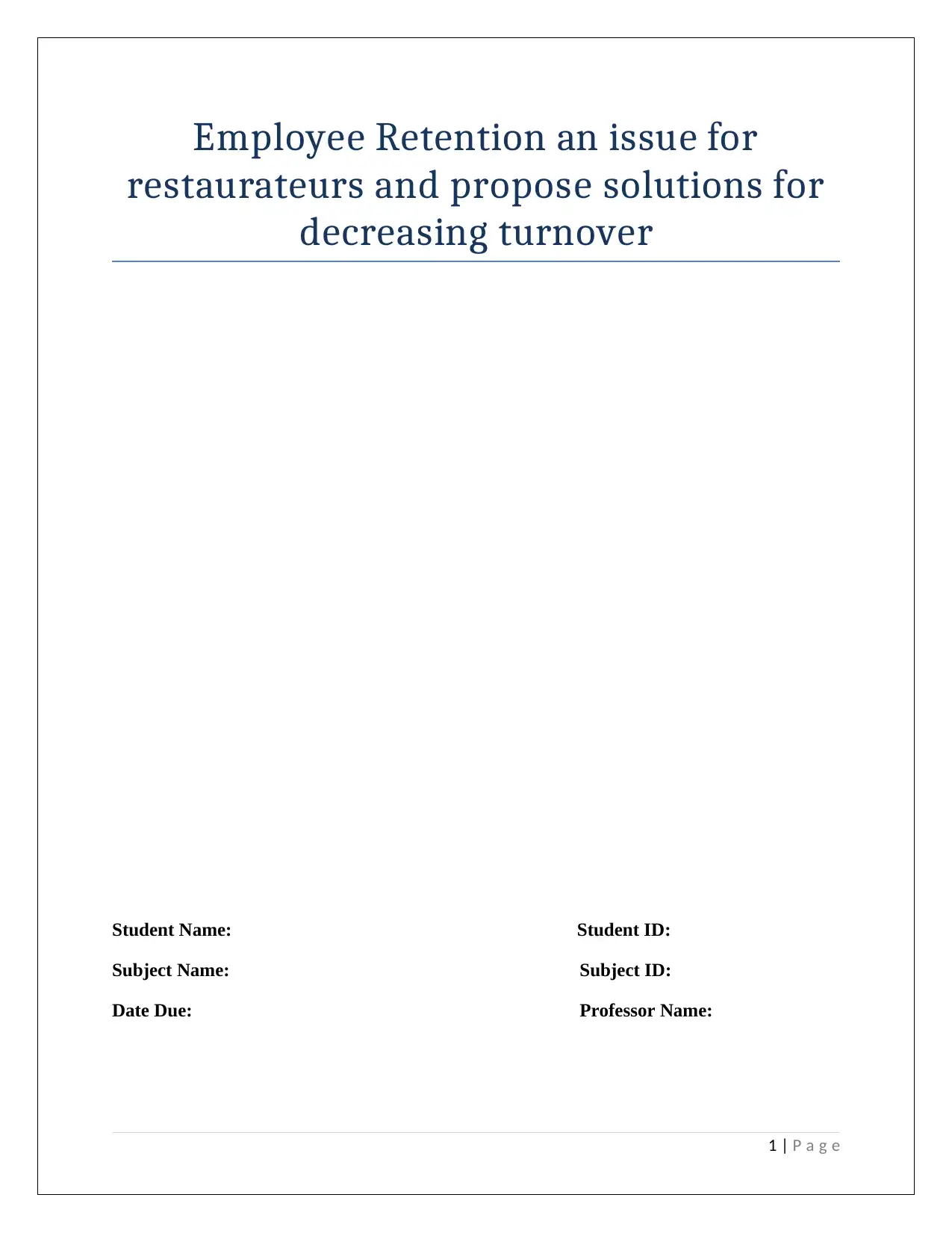
Employee Retention an issue for
restaurateurs and propose solutions for
decreasing turnover
Student Name: Student ID:
Subject Name: Subject ID:
Date Due: Professor Name:
1 | P a g e
restaurateurs and propose solutions for
decreasing turnover
Student Name: Student ID:
Subject Name: Subject ID:
Date Due: Professor Name:
1 | P a g e
Paraphrase This Document
Need a fresh take? Get an instant paraphrase of this document with our AI Paraphraser
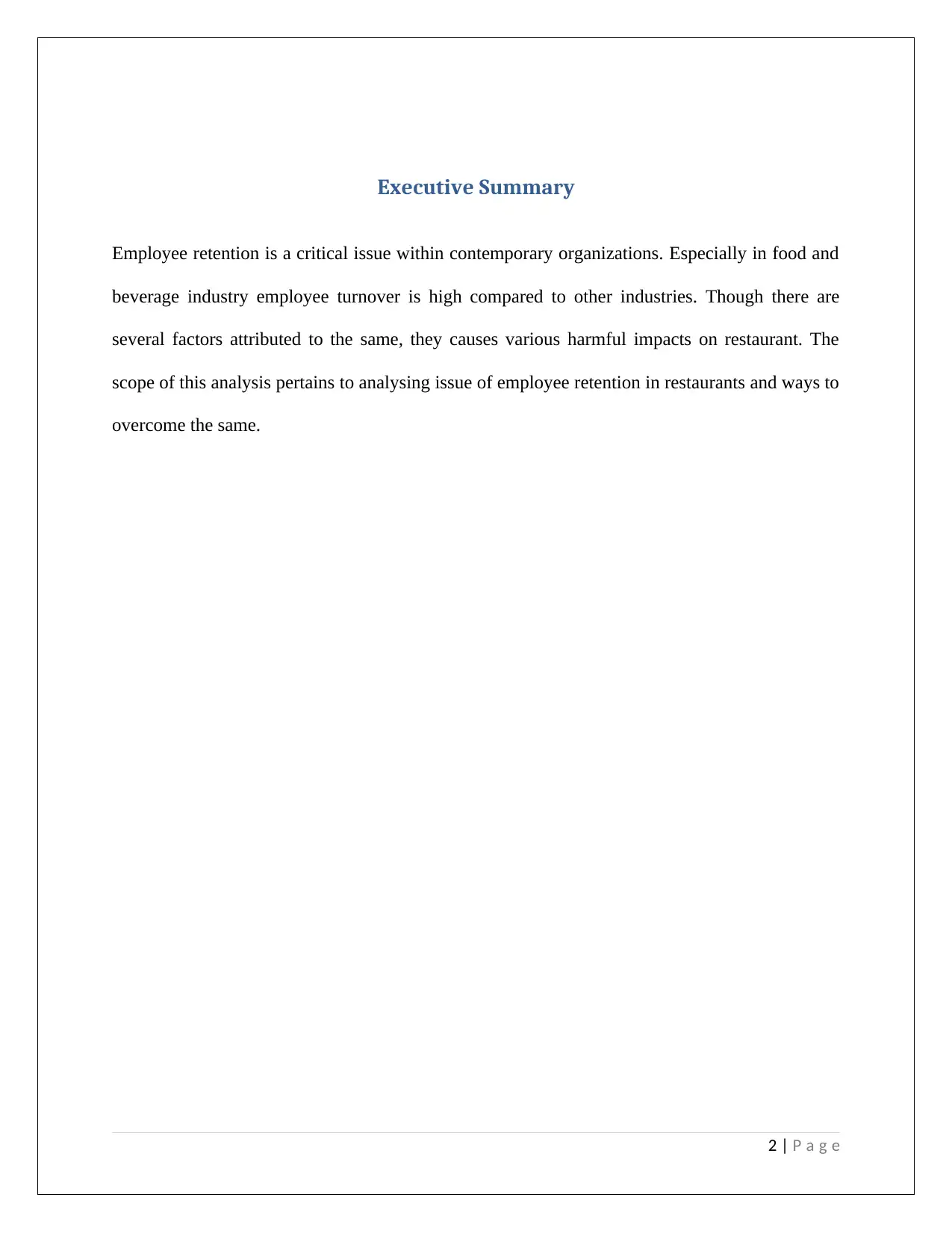
Executive Summary
Employee retention is a critical issue within contemporary organizations. Especially in food and
beverage industry employee turnover is high compared to other industries. Though there are
several factors attributed to the same, they causes various harmful impacts on restaurant. The
scope of this analysis pertains to analysing issue of employee retention in restaurants and ways to
overcome the same.
2 | P a g e
Employee retention is a critical issue within contemporary organizations. Especially in food and
beverage industry employee turnover is high compared to other industries. Though there are
several factors attributed to the same, they causes various harmful impacts on restaurant. The
scope of this analysis pertains to analysing issue of employee retention in restaurants and ways to
overcome the same.
2 | P a g e
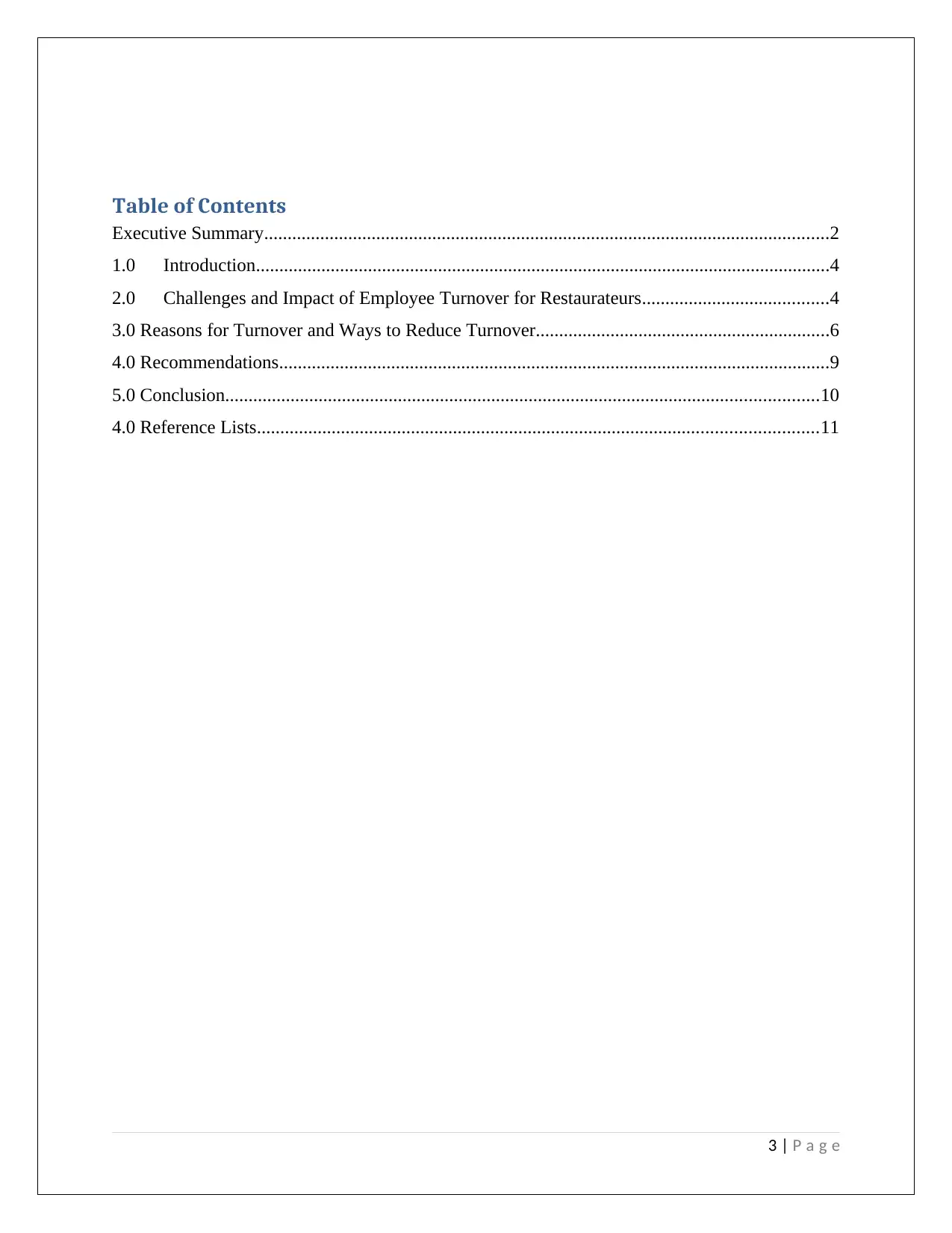
Table of Contents
Executive Summary.........................................................................................................................2
1.0 Introduction...........................................................................................................................4
2.0 Challenges and Impact of Employee Turnover for Restaurateurs........................................4
3.0 Reasons for Turnover and Ways to Reduce Turnover...............................................................6
4.0 Recommendations......................................................................................................................9
5.0 Conclusion...............................................................................................................................10
4.0 Reference Lists........................................................................................................................11
3 | P a g e
Executive Summary.........................................................................................................................2
1.0 Introduction...........................................................................................................................4
2.0 Challenges and Impact of Employee Turnover for Restaurateurs........................................4
3.0 Reasons for Turnover and Ways to Reduce Turnover...............................................................6
4.0 Recommendations......................................................................................................................9
5.0 Conclusion...............................................................................................................................10
4.0 Reference Lists........................................................................................................................11
3 | P a g e
⊘ This is a preview!⊘
Do you want full access?
Subscribe today to unlock all pages.

Trusted by 1+ million students worldwide

1.0 Introduction
Employee is the most important resource for any organization. Restaurant industry in the
whole world constitutes economy’s greatest employer of teens (Ton, 2008). Every 1 amongst 3
teenagers are employed in restaurants as examined by the Bureau of Labor Statistics. Due to the
seasonality of the industry, staffing levels greatly vary as during summers staffing needs gets
added, which significantly gets reduced during other months of the year. Almost as high as 31%
workforce within restaurant industry is part-time or seasonal in nature. Inspite of all these
conditions employee retention is an immense issue that is experienced across restaurants of the
world. Employee absenteeism and employee leaving is high compared to total number of
retained employees. The scope of this report analysis the issue of employee retention with ways
of overcoming it in restaurant businesses.
2.0 Challenges and Impact of Employee Turnover for Restaurateurs
Employers control various aspects of an employee’s work at a restaurant but employees due
to certain dissatisfactions leave jobs. Employee turnover is expensive and can results from
various issues of the management (Alonso, 2009). While U.S. Bureau of Labor Statistics attach
33 percent of employee turnover issue to compensation as benefits and wages. But other factors
as employee morale immensely impacts negatively employee effectiveness and efficiency.
Employee turnover can have serious consequences on any restaurant impacting their operations
and cost factor in various manner. Most integral impact of employee turnover is cost related to
lost productivity and replacement costs. When an employee leaves the organization, there needs
to be advertisement, recruitment, selection, interview procedure and then subsequent training and
induction. These costs add up to a substantial amount that restaurateurs have to bear regularly as
4 | P a g e
Employee is the most important resource for any organization. Restaurant industry in the
whole world constitutes economy’s greatest employer of teens (Ton, 2008). Every 1 amongst 3
teenagers are employed in restaurants as examined by the Bureau of Labor Statistics. Due to the
seasonality of the industry, staffing levels greatly vary as during summers staffing needs gets
added, which significantly gets reduced during other months of the year. Almost as high as 31%
workforce within restaurant industry is part-time or seasonal in nature. Inspite of all these
conditions employee retention is an immense issue that is experienced across restaurants of the
world. Employee absenteeism and employee leaving is high compared to total number of
retained employees. The scope of this report analysis the issue of employee retention with ways
of overcoming it in restaurant businesses.
2.0 Challenges and Impact of Employee Turnover for Restaurateurs
Employers control various aspects of an employee’s work at a restaurant but employees due
to certain dissatisfactions leave jobs. Employee turnover is expensive and can results from
various issues of the management (Alonso, 2009). While U.S. Bureau of Labor Statistics attach
33 percent of employee turnover issue to compensation as benefits and wages. But other factors
as employee morale immensely impacts negatively employee effectiveness and efficiency.
Employee turnover can have serious consequences on any restaurant impacting their operations
and cost factor in various manner. Most integral impact of employee turnover is cost related to
lost productivity and replacement costs. When an employee leaves the organization, there needs
to be advertisement, recruitment, selection, interview procedure and then subsequent training and
induction. These costs add up to a substantial amount that restaurateurs have to bear regularly as
4 | P a g e
Paraphrase This Document
Need a fresh take? Get an instant paraphrase of this document with our AI Paraphraser

their attrition rates are high. Moreover when an employee leaves, immediately that position is not
fulfilled leading to loss of productivity. In restaurants, customers might prefer a particular chef’s
or cook’s preparation compared to another. Customers might prefer services of some waiter
compared to another, when the waiter or chef leaves it creates a negative impact on the customer.
Customer is either hesitant to visit the restaurant again or order the similar dish that he
ordered last time. Hence, affecting productivity, loss of revenue and profitability for the
organization.
Employee turnover can lead to loss of valuable talent pool for the restaurant, which might
be difficult to fulfill. In case a restaurant experiences high levels of turnover, then they might
lose out on talents that are difficult to acquire. When a restaurant loses talent it leads to lowering
of quality service which in turn affects customers (Camillo, 2008). Once customers starts losing
their confidence in the restaurant it leads to negative impact within the competitive space. It
might impact losing out on valuable customers and hence revenue for the restaurant.
Employees that work within the organization are aware regarding organization practice and
technology prevailing. Some restaurants might use grills other might make use of electrical
ovens for making certain preparations. These trends largely vary across restaurants and
employees are aware of the technology. They are well equipped to maintain the competitive edge
and deliver preparations according to such standards. When a restaurant loses employees, they
need to retrain their staffs regarding such technology and preparation standards. It leads to losing
out on the competitive edge, which might be exploited by a competitor (Samuel, 2009).
Therefore, it can be understood from this, employee turnover in restaurants can impact customers
as well as competitive edge in a negative manner.
5 | P a g e
fulfilled leading to loss of productivity. In restaurants, customers might prefer a particular chef’s
or cook’s preparation compared to another. Customers might prefer services of some waiter
compared to another, when the waiter or chef leaves it creates a negative impact on the customer.
Customer is either hesitant to visit the restaurant again or order the similar dish that he
ordered last time. Hence, affecting productivity, loss of revenue and profitability for the
organization.
Employee turnover can lead to loss of valuable talent pool for the restaurant, which might
be difficult to fulfill. In case a restaurant experiences high levels of turnover, then they might
lose out on talents that are difficult to acquire. When a restaurant loses talent it leads to lowering
of quality service which in turn affects customers (Camillo, 2008). Once customers starts losing
their confidence in the restaurant it leads to negative impact within the competitive space. It
might impact losing out on valuable customers and hence revenue for the restaurant.
Employees that work within the organization are aware regarding organization practice and
technology prevailing. Some restaurants might use grills other might make use of electrical
ovens for making certain preparations. These trends largely vary across restaurants and
employees are aware of the technology. They are well equipped to maintain the competitive edge
and deliver preparations according to such standards. When a restaurant loses employees, they
need to retrain their staffs regarding such technology and preparation standards. It leads to losing
out on the competitive edge, which might be exploited by a competitor (Samuel, 2009).
Therefore, it can be understood from this, employee turnover in restaurants can impact customers
as well as competitive edge in a negative manner.
5 | P a g e
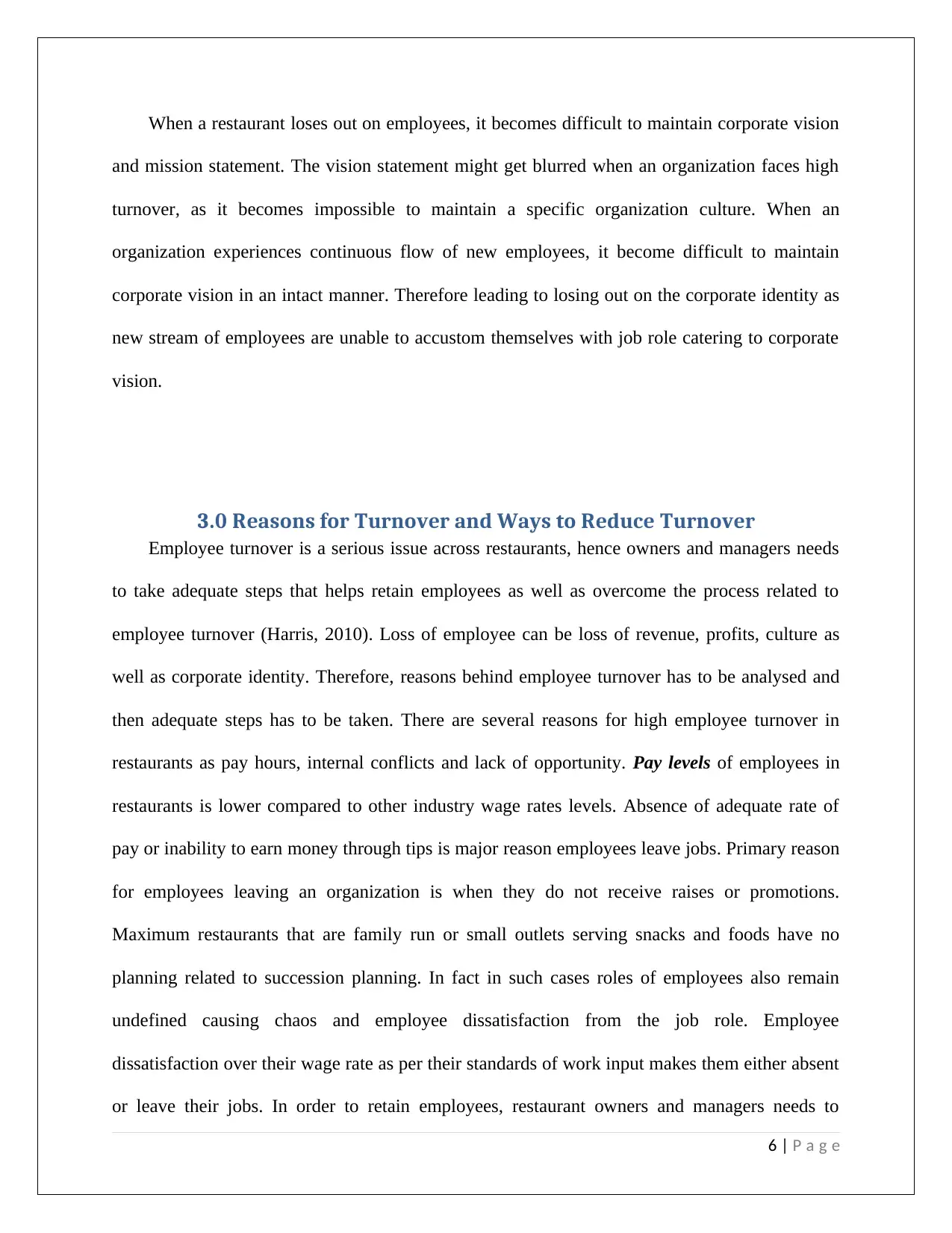
When a restaurant loses out on employees, it becomes difficult to maintain corporate vision
and mission statement. The vision statement might get blurred when an organization faces high
turnover, as it becomes impossible to maintain a specific organization culture. When an
organization experiences continuous flow of new employees, it become difficult to maintain
corporate vision in an intact manner. Therefore leading to losing out on the corporate identity as
new stream of employees are unable to accustom themselves with job role catering to corporate
vision.
3.0 Reasons for Turnover and Ways to Reduce Turnover
Employee turnover is a serious issue across restaurants, hence owners and managers needs
to take adequate steps that helps retain employees as well as overcome the process related to
employee turnover (Harris, 2010). Loss of employee can be loss of revenue, profits, culture as
well as corporate identity. Therefore, reasons behind employee turnover has to be analysed and
then adequate steps has to be taken. There are several reasons for high employee turnover in
restaurants as pay hours, internal conflicts and lack of opportunity. Pay levels of employees in
restaurants is lower compared to other industry wage rates levels. Absence of adequate rate of
pay or inability to earn money through tips is major reason employees leave jobs. Primary reason
for employees leaving an organization is when they do not receive raises or promotions.
Maximum restaurants that are family run or small outlets serving snacks and foods have no
planning related to succession planning. In fact in such cases roles of employees also remain
undefined causing chaos and employee dissatisfaction from the job role. Employee
dissatisfaction over their wage rate as per their standards of work input makes them either absent
or leave their jobs. In order to retain employees, restaurant owners and managers needs to
6 | P a g e
and mission statement. The vision statement might get blurred when an organization faces high
turnover, as it becomes impossible to maintain a specific organization culture. When an
organization experiences continuous flow of new employees, it become difficult to maintain
corporate vision in an intact manner. Therefore leading to losing out on the corporate identity as
new stream of employees are unable to accustom themselves with job role catering to corporate
vision.
3.0 Reasons for Turnover and Ways to Reduce Turnover
Employee turnover is a serious issue across restaurants, hence owners and managers needs
to take adequate steps that helps retain employees as well as overcome the process related to
employee turnover (Harris, 2010). Loss of employee can be loss of revenue, profits, culture as
well as corporate identity. Therefore, reasons behind employee turnover has to be analysed and
then adequate steps has to be taken. There are several reasons for high employee turnover in
restaurants as pay hours, internal conflicts and lack of opportunity. Pay levels of employees in
restaurants is lower compared to other industry wage rates levels. Absence of adequate rate of
pay or inability to earn money through tips is major reason employees leave jobs. Primary reason
for employees leaving an organization is when they do not receive raises or promotions.
Maximum restaurants that are family run or small outlets serving snacks and foods have no
planning related to succession planning. In fact in such cases roles of employees also remain
undefined causing chaos and employee dissatisfaction from the job role. Employee
dissatisfaction over their wage rate as per their standards of work input makes them either absent
or leave their jobs. In order to retain employees, restaurant owners and managers needs to
6 | P a g e
⊘ This is a preview!⊘
Do you want full access?
Subscribe today to unlock all pages.

Trusted by 1+ million students worldwide
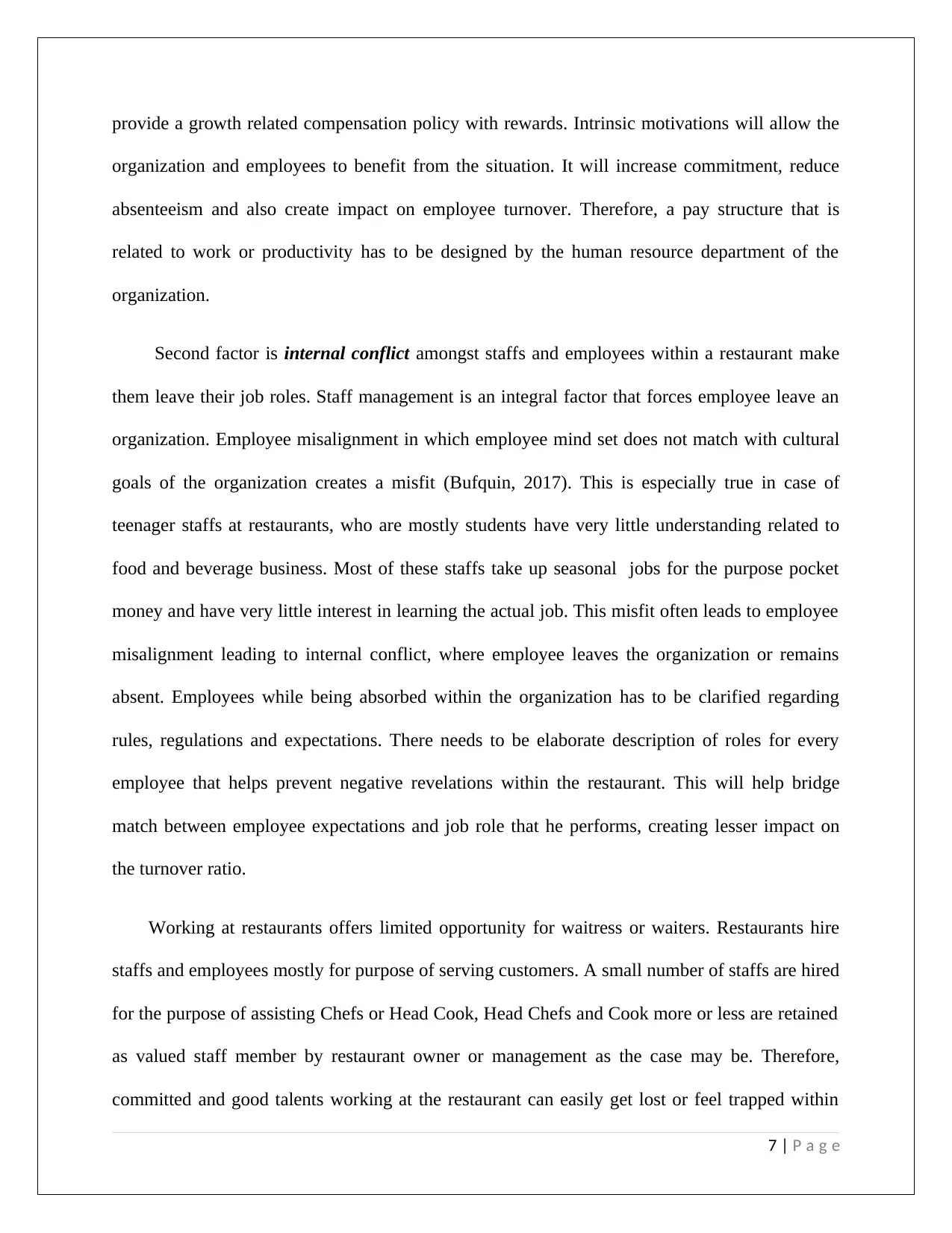
provide a growth related compensation policy with rewards. Intrinsic motivations will allow the
organization and employees to benefit from the situation. It will increase commitment, reduce
absenteeism and also create impact on employee turnover. Therefore, a pay structure that is
related to work or productivity has to be designed by the human resource department of the
organization.
Second factor is internal conflict amongst staffs and employees within a restaurant make
them leave their job roles. Staff management is an integral factor that forces employee leave an
organization. Employee misalignment in which employee mind set does not match with cultural
goals of the organization creates a misfit (Bufquin, 2017). This is especially true in case of
teenager staffs at restaurants, who are mostly students have very little understanding related to
food and beverage business. Most of these staffs take up seasonal jobs for the purpose pocket
money and have very little interest in learning the actual job. This misfit often leads to employee
misalignment leading to internal conflict, where employee leaves the organization or remains
absent. Employees while being absorbed within the organization has to be clarified regarding
rules, regulations and expectations. There needs to be elaborate description of roles for every
employee that helps prevent negative revelations within the restaurant. This will help bridge
match between employee expectations and job role that he performs, creating lesser impact on
the turnover ratio.
Working at restaurants offers limited opportunity for waitress or waiters. Restaurants hire
staffs and employees mostly for purpose of serving customers. A small number of staffs are hired
for the purpose of assisting Chefs or Head Cook, Head Chefs and Cook more or less are retained
as valued staff member by restaurant owner or management as the case may be. Therefore,
committed and good talents working at the restaurant can easily get lost or feel trapped within
7 | P a g e
organization and employees to benefit from the situation. It will increase commitment, reduce
absenteeism and also create impact on employee turnover. Therefore, a pay structure that is
related to work or productivity has to be designed by the human resource department of the
organization.
Second factor is internal conflict amongst staffs and employees within a restaurant make
them leave their job roles. Staff management is an integral factor that forces employee leave an
organization. Employee misalignment in which employee mind set does not match with cultural
goals of the organization creates a misfit (Bufquin, 2017). This is especially true in case of
teenager staffs at restaurants, who are mostly students have very little understanding related to
food and beverage business. Most of these staffs take up seasonal jobs for the purpose pocket
money and have very little interest in learning the actual job. This misfit often leads to employee
misalignment leading to internal conflict, where employee leaves the organization or remains
absent. Employees while being absorbed within the organization has to be clarified regarding
rules, regulations and expectations. There needs to be elaborate description of roles for every
employee that helps prevent negative revelations within the restaurant. This will help bridge
match between employee expectations and job role that he performs, creating lesser impact on
the turnover ratio.
Working at restaurants offers limited opportunity for waitress or waiters. Restaurants hire
staffs and employees mostly for purpose of serving customers. A small number of staffs are hired
for the purpose of assisting Chefs or Head Cook, Head Chefs and Cook more or less are retained
as valued staff member by restaurant owner or management as the case may be. Therefore,
committed and good talents working at the restaurant can easily get lost or feel trapped within
7 | P a g e
Paraphrase This Document
Need a fresh take? Get an instant paraphrase of this document with our AI Paraphraser
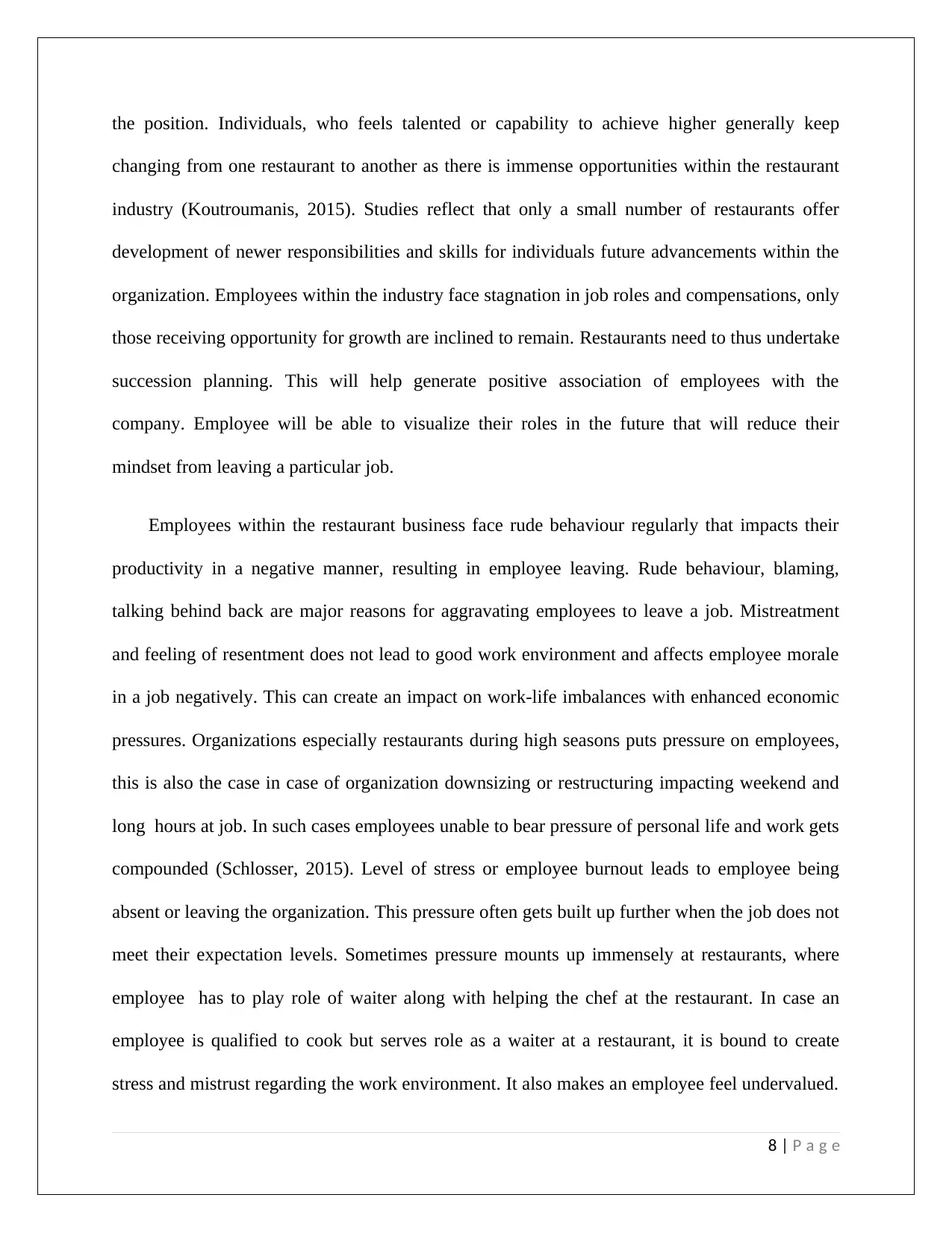
the position. Individuals, who feels talented or capability to achieve higher generally keep
changing from one restaurant to another as there is immense opportunities within the restaurant
industry (Koutroumanis, 2015). Studies reflect that only a small number of restaurants offer
development of newer responsibilities and skills for individuals future advancements within the
organization. Employees within the industry face stagnation in job roles and compensations, only
those receiving opportunity for growth are inclined to remain. Restaurants need to thus undertake
succession planning. This will help generate positive association of employees with the
company. Employee will be able to visualize their roles in the future that will reduce their
mindset from leaving a particular job.
Employees within the restaurant business face rude behaviour regularly that impacts their
productivity in a negative manner, resulting in employee leaving. Rude behaviour, blaming,
talking behind back are major reasons for aggravating employees to leave a job. Mistreatment
and feeling of resentment does not lead to good work environment and affects employee morale
in a job negatively. This can create an impact on work-life imbalances with enhanced economic
pressures. Organizations especially restaurants during high seasons puts pressure on employees,
this is also the case in case of organization downsizing or restructuring impacting weekend and
long hours at job. In such cases employees unable to bear pressure of personal life and work gets
compounded (Schlosser, 2015). Level of stress or employee burnout leads to employee being
absent or leaving the organization. This pressure often gets built up further when the job does not
meet their expectation levels. Sometimes pressure mounts up immensely at restaurants, where
employee has to play role of waiter along with helping the chef at the restaurant. In case an
employee is qualified to cook but serves role as a waiter at a restaurant, it is bound to create
stress and mistrust regarding the work environment. It also makes an employee feel undervalued.
8 | P a g e
changing from one restaurant to another as there is immense opportunities within the restaurant
industry (Koutroumanis, 2015). Studies reflect that only a small number of restaurants offer
development of newer responsibilities and skills for individuals future advancements within the
organization. Employees within the industry face stagnation in job roles and compensations, only
those receiving opportunity for growth are inclined to remain. Restaurants need to thus undertake
succession planning. This will help generate positive association of employees with the
company. Employee will be able to visualize their roles in the future that will reduce their
mindset from leaving a particular job.
Employees within the restaurant business face rude behaviour regularly that impacts their
productivity in a negative manner, resulting in employee leaving. Rude behaviour, blaming,
talking behind back are major reasons for aggravating employees to leave a job. Mistreatment
and feeling of resentment does not lead to good work environment and affects employee morale
in a job negatively. This can create an impact on work-life imbalances with enhanced economic
pressures. Organizations especially restaurants during high seasons puts pressure on employees,
this is also the case in case of organization downsizing or restructuring impacting weekend and
long hours at job. In such cases employees unable to bear pressure of personal life and work gets
compounded (Schlosser, 2015). Level of stress or employee burnout leads to employee being
absent or leaving the organization. This pressure often gets built up further when the job does not
meet their expectation levels. Sometimes pressure mounts up immensely at restaurants, where
employee has to play role of waiter along with helping the chef at the restaurant. In case an
employee is qualified to cook but serves role as a waiter at a restaurant, it is bound to create
stress and mistrust regarding the work environment. It also makes an employee feel undervalued.
8 | P a g e
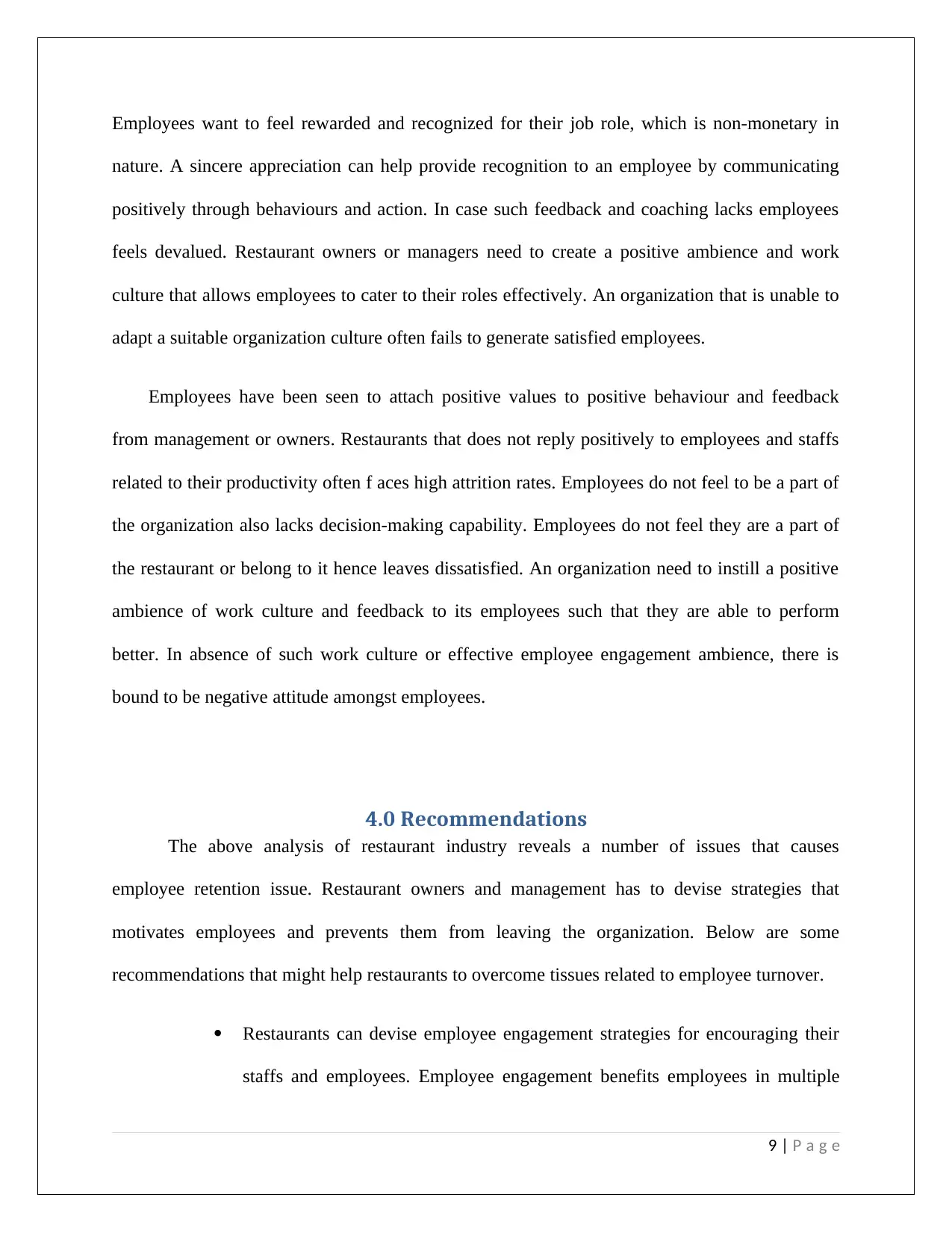
Employees want to feel rewarded and recognized for their job role, which is non-monetary in
nature. A sincere appreciation can help provide recognition to an employee by communicating
positively through behaviours and action. In case such feedback and coaching lacks employees
feels devalued. Restaurant owners or managers need to create a positive ambience and work
culture that allows employees to cater to their roles effectively. An organization that is unable to
adapt a suitable organization culture often fails to generate satisfied employees.
Employees have been seen to attach positive values to positive behaviour and feedback
from management or owners. Restaurants that does not reply positively to employees and staffs
related to their productivity often f aces high attrition rates. Employees do not feel to be a part of
the organization also lacks decision-making capability. Employees do not feel they are a part of
the restaurant or belong to it hence leaves dissatisfied. An organization need to instill a positive
ambience of work culture and feedback to its employees such that they are able to perform
better. In absence of such work culture or effective employee engagement ambience, there is
bound to be negative attitude amongst employees.
4.0 Recommendations
The above analysis of restaurant industry reveals a number of issues that causes
employee retention issue. Restaurant owners and management has to devise strategies that
motivates employees and prevents them from leaving the organization. Below are some
recommendations that might help restaurants to overcome tissues related to employee turnover.
Restaurants can devise employee engagement strategies for encouraging their
staffs and employees. Employee engagement benefits employees in multiple
9 | P a g e
nature. A sincere appreciation can help provide recognition to an employee by communicating
positively through behaviours and action. In case such feedback and coaching lacks employees
feels devalued. Restaurant owners or managers need to create a positive ambience and work
culture that allows employees to cater to their roles effectively. An organization that is unable to
adapt a suitable organization culture often fails to generate satisfied employees.
Employees have been seen to attach positive values to positive behaviour and feedback
from management or owners. Restaurants that does not reply positively to employees and staffs
related to their productivity often f aces high attrition rates. Employees do not feel to be a part of
the organization also lacks decision-making capability. Employees do not feel they are a part of
the restaurant or belong to it hence leaves dissatisfied. An organization need to instill a positive
ambience of work culture and feedback to its employees such that they are able to perform
better. In absence of such work culture or effective employee engagement ambience, there is
bound to be negative attitude amongst employees.
4.0 Recommendations
The above analysis of restaurant industry reveals a number of issues that causes
employee retention issue. Restaurant owners and management has to devise strategies that
motivates employees and prevents them from leaving the organization. Below are some
recommendations that might help restaurants to overcome tissues related to employee turnover.
Restaurants can devise employee engagement strategies for encouraging their
staffs and employees. Employee engagement benefits employees in multiple
9 | P a g e
⊘ This is a preview!⊘
Do you want full access?
Subscribe today to unlock all pages.

Trusted by 1+ million students worldwide

number of ways by impacting levels of motivation and making employees feel
a part of the company.
Owners and managers can interact in a positive manner providing good
feedback about the employee. This will aid employee react positively within
the organization environment.
Restaurants needs to build a sense of positivity and growth related culture for
overall benefit of the organization and its employees.
5.0 Conclusion
Restaurateurs can successfully overcome issue of employee turnover and apply employee
engagement strategies. Contemporary organizations today are accommodating employee
engagement strategies in order to overcome issues related to employee turnover and apply
employee motivational strategies. Employee engagement strategies as motivation, training and
other development programs helps employee feel a part of the organization, increases their
commitment levels. This has be shown to affect employee motivation in a positive manner
reducing their absenteeism and turnover.
10 | P a g e
a part of the company.
Owners and managers can interact in a positive manner providing good
feedback about the employee. This will aid employee react positively within
the organization environment.
Restaurants needs to build a sense of positivity and growth related culture for
overall benefit of the organization and its employees.
5.0 Conclusion
Restaurateurs can successfully overcome issue of employee turnover and apply employee
engagement strategies. Contemporary organizations today are accommodating employee
engagement strategies in order to overcome issues related to employee turnover and apply
employee motivational strategies. Employee engagement strategies as motivation, training and
other development programs helps employee feel a part of the organization, increases their
commitment levels. This has be shown to affect employee motivation in a positive manner
reducing their absenteeism and turnover.
10 | P a g e
Paraphrase This Document
Need a fresh take? Get an instant paraphrase of this document with our AI Paraphraser

4.0 Reference Lists
Allen, D. G., Bryant, P. C., & Vardaman, J. M. (2010). Retaining talent: Replacing
misconceptions with evidence-based strategies. The Academy of Management
Perspectives, 24(2), 48-64.
Alonso, A. D., & O’Neill, M. A. (2009). Staffing issues among small hospitality businesses: A
college town case. International Journal of Hospitality Management, 28(4), 573-578.
Bufquin, D., DiPietro, R., Orlowski, M., & Partlow, C. (2017). The influence of restaurant co-
workers’ perceived warmth and competence on employees’ turnover intentions: The
mediating role of job attitudes. International Journal of Hospitality Management, 60, 13-
22.
Camillo, A. A., Connolly, D. J., & Kim, W. G. (2008). Success and failure in Northern
California: Critical success factors for independent restaurants. Cornell Hospitality
Quarterly, 49(4), 364-380.
Christensen Hughes, J., & Rog, E. (2008). Talent management: A strategy for improving
employee recruitment, retention and engagement within hospitality
organizations. International Journal of Contemporary Hospitality Management, 20(7),
743-757.
Deery, M. (2008). Talent management, work-life balance and retention strategies. International
Journal of Contemporary Hospitality Management, 20(7), 792-806.
Harris, M. J. (2010). An employee retention strategy designed to increase tenure and profitability
in the fast food industry (Doctoral dissertation, University of Phoenix).
Hausknecht, J. P., Rodda, J., & Howard, M. J. (2009). Targeted employee retention:
Performance‐based and job‐related differences in reported reasons for staying. Human
Resource Management, 48(2), 269-288.
Kompaso, S. M., & Sridevi, M. S. (2010). Employee engagement: The key to improving
performance. International journal of business and management, 5(12), 89.
11 | P a g e
Allen, D. G., Bryant, P. C., & Vardaman, J. M. (2010). Retaining talent: Replacing
misconceptions with evidence-based strategies. The Academy of Management
Perspectives, 24(2), 48-64.
Alonso, A. D., & O’Neill, M. A. (2009). Staffing issues among small hospitality businesses: A
college town case. International Journal of Hospitality Management, 28(4), 573-578.
Bufquin, D., DiPietro, R., Orlowski, M., & Partlow, C. (2017). The influence of restaurant co-
workers’ perceived warmth and competence on employees’ turnover intentions: The
mediating role of job attitudes. International Journal of Hospitality Management, 60, 13-
22.
Camillo, A. A., Connolly, D. J., & Kim, W. G. (2008). Success and failure in Northern
California: Critical success factors for independent restaurants. Cornell Hospitality
Quarterly, 49(4), 364-380.
Christensen Hughes, J., & Rog, E. (2008). Talent management: A strategy for improving
employee recruitment, retention and engagement within hospitality
organizations. International Journal of Contemporary Hospitality Management, 20(7),
743-757.
Deery, M. (2008). Talent management, work-life balance and retention strategies. International
Journal of Contemporary Hospitality Management, 20(7), 792-806.
Harris, M. J. (2010). An employee retention strategy designed to increase tenure and profitability
in the fast food industry (Doctoral dissertation, University of Phoenix).
Hausknecht, J. P., Rodda, J., & Howard, M. J. (2009). Targeted employee retention:
Performance‐based and job‐related differences in reported reasons for staying. Human
Resource Management, 48(2), 269-288.
Kompaso, S. M., & Sridevi, M. S. (2010). Employee engagement: The key to improving
performance. International journal of business and management, 5(12), 89.
11 | P a g e
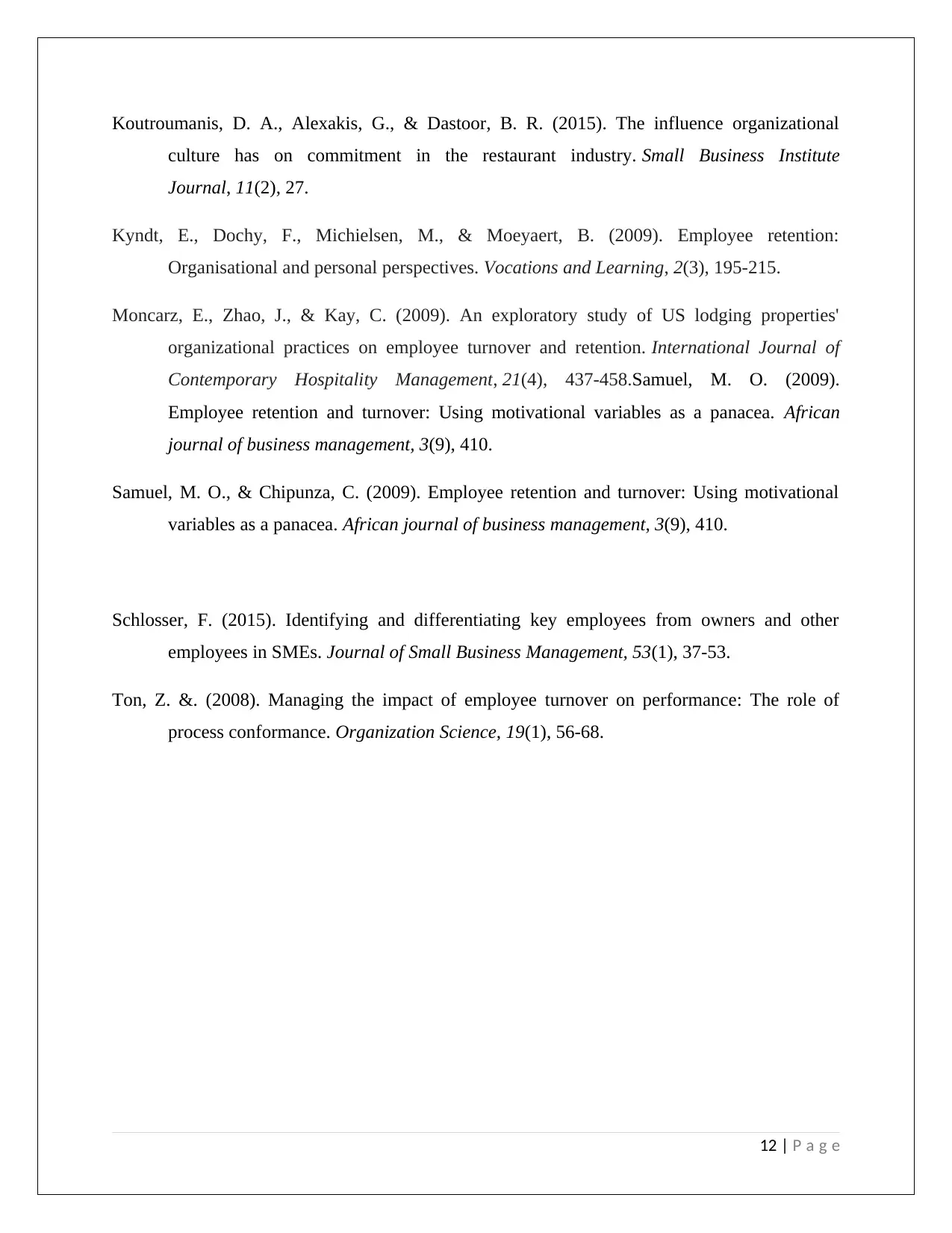
Koutroumanis, D. A., Alexakis, G., & Dastoor, B. R. (2015). The influence organizational
culture has on commitment in the restaurant industry. Small Business Institute
Journal, 11(2), 27.
Kyndt, E., Dochy, F., Michielsen, M., & Moeyaert, B. (2009). Employee retention:
Organisational and personal perspectives. Vocations and Learning, 2(3), 195-215.
Moncarz, E., Zhao, J., & Kay, C. (2009). An exploratory study of US lodging properties'
organizational practices on employee turnover and retention. International Journal of
Contemporary Hospitality Management, 21(4), 437-458.Samuel, M. O. (2009).
Employee retention and turnover: Using motivational variables as a panacea. African
journal of business management, 3(9), 410.
Samuel, M. O., & Chipunza, C. (2009). Employee retention and turnover: Using motivational
variables as a panacea. African journal of business management, 3(9), 410.
Schlosser, F. (2015). Identifying and differentiating key employees from owners and other
employees in SMEs. Journal of Small Business Management, 53(1), 37-53.
Ton, Z. &. (2008). Managing the impact of employee turnover on performance: The role of
process conformance. Organization Science, 19(1), 56-68.
12 | P a g e
culture has on commitment in the restaurant industry. Small Business Institute
Journal, 11(2), 27.
Kyndt, E., Dochy, F., Michielsen, M., & Moeyaert, B. (2009). Employee retention:
Organisational and personal perspectives. Vocations and Learning, 2(3), 195-215.
Moncarz, E., Zhao, J., & Kay, C. (2009). An exploratory study of US lodging properties'
organizational practices on employee turnover and retention. International Journal of
Contemporary Hospitality Management, 21(4), 437-458.Samuel, M. O. (2009).
Employee retention and turnover: Using motivational variables as a panacea. African
journal of business management, 3(9), 410.
Samuel, M. O., & Chipunza, C. (2009). Employee retention and turnover: Using motivational
variables as a panacea. African journal of business management, 3(9), 410.
Schlosser, F. (2015). Identifying and differentiating key employees from owners and other
employees in SMEs. Journal of Small Business Management, 53(1), 37-53.
Ton, Z. &. (2008). Managing the impact of employee turnover on performance: The role of
process conformance. Organization Science, 19(1), 56-68.
12 | P a g e
⊘ This is a preview!⊘
Do you want full access?
Subscribe today to unlock all pages.

Trusted by 1+ million students worldwide
1 out of 13
Related Documents
Your All-in-One AI-Powered Toolkit for Academic Success.
+13062052269
info@desklib.com
Available 24*7 on WhatsApp / Email
![[object Object]](/_next/static/media/star-bottom.7253800d.svg)
Unlock your academic potential
Copyright © 2020–2025 A2Z Services. All Rights Reserved. Developed and managed by ZUCOL.





